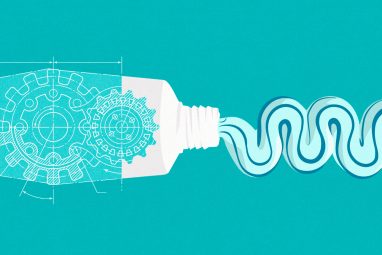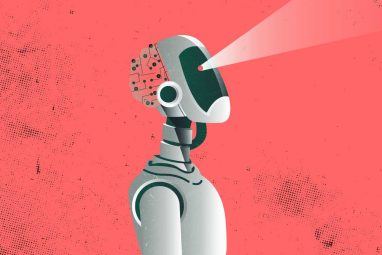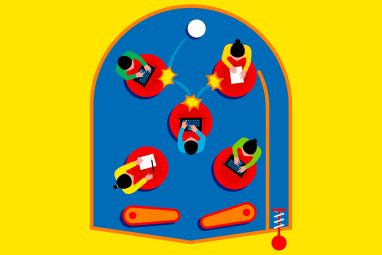Lego Takes Customers’ Innovations Further
Three new insights about Lego Group’s open innovation practices highlight the benefits of integrating customer communities into product development operations.
News
- More than 80% of Saudi CEOs adopted an AI-first approach in 2024, study finds
- UiPath Test Cloud Brings AI-Driven Automation to Software Testing
- Oracle Launches AI Agent Studio for Customizable Enterprise Automation
- VAST Data and NVIDIA Launch Secure, Scalable AI Stack for Enterprises
- How Machine Identity Risks Are Escalating in AI-Powered Enterprises
- How Agentic AI Is Reshaping Healthcare

Patrick George
It is rare for companies to generate consistent commercial hits from their customers’ ideas. In fact, customer-generated innovation efforts tend to be ad hoc or difficult to sustain.1 But when they succeed, they can create new sources of revenue, outcompete internally generated ideas, and create more loyalty among customers — which explains why business leaders continue to pursue this path for idea generation.2
The Lego Group has been one of the most widely researched and emulated companies for its open innovation achievements with consumers. A crowdsourcing pilot that Lego launched in 2008 evolved into Lego Ideas, a community of more than 2.8 million customers that has shared and debated more than 135,000 ideas for Lego sets and generated significant revenues for the company. The lucky few whose ideas are commercialized (like the top-selling medieval blacksmith set) get 1% of the product’s top-line revenue — often a life-changing sum. Meanwhile, popular ideas that are not selected as Lego products can get a second chance through a crowdfunding program on BrickLink, a consumer-led channel that Lego acquired in 2019.
Our four-year study of Lego Ideas and BrickLink has uncovered fresh insights for managing open innovation platforms. Many open innovation initiatives start on the edge, as Lego’s did, and remain there. To create value over time, however, they need to be integrated into the organization’s core.3 We looked at how Lego involves customers in choosing hit products, provides an outlet for customers whose ideas are rejected, and enables customers to profit from their creations. Our findings could help business leaders strengthen their customer communities and keep members active in revenue creation, in part by integrating members into their product development and marketing operations.
Insight 1: Let Customers Find the Hits
Participants in the Lego Ideas community generate many more ideas than the Lego Group can implement. To winnow the field, customers vote for the best ideas in a multiround competition. The winners — ideas that gain support from 10,000 customers within a specific time frame — enter the final selection process, in which Lego Group employees determine which designs will join the Lego product portfolio.
The question is whether the online community does a better job at choosing the ideas that ultimately win compared with relying on employees to vet each raw idea. That is, does it matter that Lego includes customers in the selection process? Prior research suggests that this is the case in other markets. For example, not only does peer influence have a significant effect on whether books, movies, and songs become hits, but the choices made by the crowd often do not match experts’ predictions about which creations will be commercially successful.4
Using machine learning, we identified the key factors that predict which ideas will garner the minimum 100 votes needed to pass the first round in Lego Ideas. We found that at this stage, participants rely on signals such as the idea proposer’s status in the community, and how an idea is framed and formulated, to filter out what they perceive as low-quality ideas and choose the ones they will support. Specifically, ideas from members whose previous proposals had gained high levels of community support were more likely to move forward. So were ideas that were accompanied by upbeat, detailed descriptions and an average of seven images.
However, predicting which ideas would receive 10,000 votes at the final stage was almost impossible. We found a large degree of randomness regarding which ideas made it to the last round after passing the initial threshold. In the end, social influence played a significant role in selecting the finalists for Lego to evaluate.
These findings suggest that although companies could apply artificial intelligence technology to select the most promising ideas from customers, such an approach would be less useful in finding the hits. An engaged customer community can contribute insights about which ideas have a certain something — call it market fitness or viability — that can’t be easily replicated. Community involvement across multiple selection stages complements the expertise within the Lego Group by detecting high-quality ideas with strong market demand.
Insight 2: Give Unhappiness an Outlet
Involving customers in selecting product ideas poses a diplomatic challenge. From 2008 to 2019, there were 148 ideas that garnered 10,000 votes, and of those, only 23 were selected for development and production by the Lego Group. Rejecting so many popular proposals could stir a backlash if not managed carefully.
We looked into how community members who supported the ideas that the Lego Group rejected reacted, by analyzing their activity before and after they learned about the company’s decisions. We found that they not only stayed on the Lego Ideas platform but also became more engaged in commenting on others’ ideas. However, when doing so, they expressed their disappointment by providing more negative feedback for about two weeks after their cherished idea was rejected.
These results illustrate that rejecting a participant’s idea can affect the wider community. That the consequences were short-lived can be attributed to participants’ high identification with the Lego Group and Lego Ideas, as revealed in interviews with participants. Customer loyalty has enabled the company to say no without destroying its community.
Members we interviewed described different ways Lego has been able to create such loyalty. One tactic has been to design the platform to encourage participants to connect individually. One member from Greece said that she has continued to participate because she values the relationships she has with fans from different countries, including France, Italy, and Spain.
Further, the company has organized fairs, in-person competitions, and test labs where Lego Ideas participants are invited to contribute. A member who frequently attends Lego shows described his luck at being invited, along with his son, to the Lego 1-90 Builders event, which was held in 2022 at the newly expanded Lego London store to celebrate the company’s 90th anniversary. Guests shared their stories of what Lego meant to them, and they had the chance to be featured alongside Lego designers in a series of 90 photographs by renowned fashion and portrait photographer Rankin.
Insight 3: Share the Wealth
Although children are Lego’s primary customers, the company has embraced opportunities to expand its reach by partnering with adults. When we interviewed Lego Ideas and BrickLink managers and observed the BrickLink Designer Program (BDP) — where members compete to have their ideas crowdfunded — we found that the company encourages not only creativity but entrepreneurship as well.
Many creators are able to earn money from their proposals outside of Lego Ideas competitions. Many fans have side careers as Lego builders, showcasing their creativity on YouTube and other social media platforms. And they have fueled demand for aftermarket sales.
A Lego enthusiast, Dan Jezek, started BrickLink in 2000, after he discovered a demand for aftermarket bricks on eBay. At first the site hosted just 15 resellers’ stores.5 Today, it hosts more than 10,000 sellers in 70 countries.6 Consumers can buy and sell bricks, sets, and original designs from each other. The Lego Group purchased BrickLink to complement Lego Ideas, providing a way to extend its relationship with adult fans and especially with a smaller niche of skilled designers. Owning BrickLink also offered Lego the possibility of better control over the quality of ideas submitted and exchanged on the platform.
The company is using BrickLink to create new revenue streams with members. It launched BDP in 2021 with a competition for members of its 10K Club — those whose ideas had garnered 10,000 votes on Lego Ideas but had not been chosen by Lego employees for commercialization. Fans could pledge money to help their favorite projects get a second chance at being realized.
If a design had at least 3,000 preorders on BrickLink, Lego assembled exclusive kits, including both bricks and a building manual, for those customers. If an idea did not get enough preorders, all rights to the idea reverted to the creator, who could do anything with it, including selling the digital building instructions on the platform.
Lego invested in the program by assigning designers to help creators test, build, and refine their projects before submitting them for crowdfunding. The company also performed quality checks on sets that were headed into production to ensure adherence to safety and legal standards as well as a first-rate building experience.
The program was well received by adult fans, according to a BrickLink manager we interviewed. Many designs reached the crowdfunding threshold of 3,000 preorders within days — or even minutes. The Lego Group has since expanded BDP to allow for submissions by anyone who lives in a country where it operates. To encourage Lego fans’ digital creativity, the company provides them with software called BrickLink Studio that they can use to design and submit their proposals.
Although the company markets the Lego Ideas competition winners through its regular retail channels, BrickLink creators market their crowdfunded ideas themselves. The kits produced are not official Lego sets, but they include a small Lego logo on the side of the box in addition to the BDP logo on the front to remind consumers of the connection with the company.
Late last year, the company announced that rather than one-off or occasional events, BDP competitions would become a permanent feature of the program, and launched two in early 2023, with winning designs expected to ship in mid- to late-2024. After BrickLink members have voted for their favorite submissions, the company will weigh crowd support alongside its own selection criteria (including creators’ design skills and digital acumen) and compatibility with its existing product portfolio to select five designs.
Finally, BrickLink members will be invited to preorder any of the five designs. Those that receive over 3,000 preorders will be manufactured in limited quantities — up to a maximum of 20,000 sets. Creators, who again will market their own designs, will receive 5% of the net sales.
End ‘Not Invented Here’
Each of the above insights highlights a way that the Lego Group has rethought how it operates to capture more benefits from customer-generated innovation. Companies often find this hard to do. Skeptical employees may resist ideas from outside — the classic not-invented-here syndrome — but they might change their attitudes after exploring the perspectives of external contributors.7 Further, working with consumers can challenge internal product developers’ professional identities. They might have to redefine what they think of as their roles.8
Lego has found productive ways to overcome these challenges by integrating its open innovation pipeline with its internal design organization in a way that capitalizes on its designers’ and marketers’ unique knowledge and expertise. Consumers’ ideas will vary in quality, and some will not appeal to a mainstream market. Lego’s internal experts have a key role in ensuring that customer-generated designs reflect the Lego brand by upholding company standards for design complexity, quality, safety, and buildability.
Because Lego Ideas and BrickLink are pillars of the company’s business strategy, the Lego Group needs to nurture the community and keep it aligned with the organization’s internal priorities. For Lego Ideas, this requires a two-pronged approach, with one team responsible for community engagement and another charged with ensuring that customers’ ideas are compatible with the larger product portfolio. The two teams cooperate to determine the best development direction for the platform.
Another team focuses on community engagement, integration, and alignment for BrickLink. It also coordinates with the Lego Ideas team to ensure that the company takes full advantage of the complementarity between the two platforms.
Lego designers still create the majority of products for the company. But by embracing Lego Ideas and BrickLink, the company ensures that a broader spectrum of ideas reaches consumers than would be developed internally and that it captures a large share of the value from these ideas.
Our four-year study of how Lego manages its customer innovation platform uncovered three important lessons for managers who seek the benefits of open innovation.
First, customers contribute to the open innovation process in two ways: by generating ideas, and by identifying the most promising ones with the highest market demand. Second, companies can mitigate negativity within customer communities when they reject customers’ ideas if they make building and sustaining customer loyalty a priority. Last, companies can deepen their relationships with customers by allowing them to earn money from their creative efforts.
The gains from open innovation are more likely to stick when companies make internal changes that help them integrate and manage collaboration with customers. Lego’s focus on keeping the customer community engaged and its contributions aligned with product strategy has enabled it to reap the benefits of increased innovation, revenues, and loyalty among its customers.
References
1. L. Dahlander and H. Piezunka, “Open to Suggestions: How Organizations Elicit Suggestions Through Proactive and Reactive Attention,” Research Policy 43, no. 5 (June 2014): 812-827.
2. D.W. Dahl, C. Fuchs, and M. Schreier, “Why and When Consumers Prefer Products of User-Driven Firms: A Social Identification Account,” Management Science 61, no. 8 (August 2015): 1978-1988.
3. J. West and M. Bogers, “Leveraging External Sources of Innovation: A Review of Research on Open Innovation,” Journal of Product Innovation Management 31, no. 4 (July 2014): 814-831; and L. Dahlander, D.M. Gann, and M.W. Wallin, “How Open Is Innovation? A Retrospective and Ideas Forward,” Research Policy 50, no. 4 (May 2021): 1-12.
4. M.J. Salganik, P.S. Dodds, and D.J. Watts, “Experimental Study of Inequality and Unpredictability in an Artificial Cultural Market,” Science 311, no. 5762 (Feb. 10, 2006): 854-856.
5. L. Hawthorne and E. Jezkova, “The Founding of BrickLink,” DanJezek.com, accessed June 26, 2023, www.danjezek.com.
6. “How BrickLink Works,” About BrickLink, BrickLink, accessed June 26, 2023, www.bricklink.com.
7. R. Katz and T. J. Allen, “Investigating the Not Invented Here (NIH) Syndrome: A Look at the Performance, Tenure, and Communication Patterns of 50 R&D Project Groups,” R&D Management 12, no. 1 (January 1982): 7-20.
8. H. Lifshitz-Assaf, “Dismantling Knowledge Boundaries at NASA: The Critical Role of Professional Identity in Open Innovation,” Administrative Science Quarterly 63, no. 4 (December 2018): 746-782.





